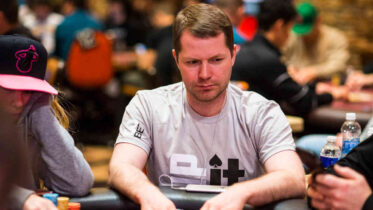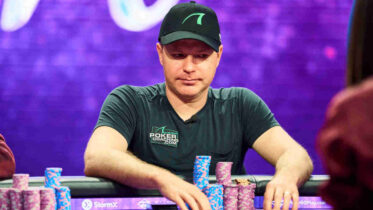Okay, I’ll admit something: It’s possible your continuation bets do not suck.
But this is the internet. I’m fighting against videos of puppies playing in a sprinkler. I have no choice but to name my articles with titles like that, otherwise you’ll never click.
And the truth is, many of us do struggle to continuation bet effectively. If you use the same continuation bet size for most hands, you’re likely struggling as well.
“No one ever folds to my continuation bets!” Have you ever said these words? That means you need to tweak your continuation betting ranges and sizes.
With just a couple of quick changes, we can pick up more pots than we deserve. The padding these orphan pots provide will lead to more profitable cash and tournament sessions.
Keep It Simple
The truth is that most people overcomplicate matters when they continue betting in Texas Hold’em.
Let’s start with some assumptions we’re making.
For one, most of the time, we will not have a hand on the flop.
The second assumption we will make is that we will want the other player to fold.
The third assumption we will make is that we are heads-up. In a multiway pot it is likely that someone hit a pair and they are not folding it. You should not continuation bet bluff in a multiway pot in low-to-mid stakes competition. You’re just not going to get folds. If you have backdoor draws or something you can work with and it’s a real hit-or-miss board (say J-2-2) you can consider it, but otherwise don’t bother.
So, let’s review. We are discussing heads-up pots where we’ve missed. How do we get the other guy to fold?
When great players are in higher-stakes tournaments, this is an extremely complex question to answer. There is the matter of balanced ranges to consider. If you overexert yourself in any frequency, your talented competition will notice and begin exploiting you. The game is to feign balanced ranges until you can slip in an exploitative play on your competition. It’s a beautiful cat-and-mouse game.
At low-to-mid stakes competition, however, our opponents aren’t as likely to notice if we’re getting out of line. This is especially true if we’re playing online versus players who are massively multitabling or just watching sports in the background.
Live isn’t much different. The next time you play live, pay attention to how many players are on their cell phones during a hand. I’m fully convinced that if you interviewed the players at your table after a hand, six or seven of them wouldn’t be able to tell you the action or the hands revealed.
In this environment, it’s best to simplify our strategies until we find more complex competition and need to lean more toward GTO poker. At this stage in your poker development, we want to get you winning. We want to get you thinking more clearly during hand, and that’s going to start with simple inputs. Once you’re clear-headed with good fundamentals, we can begin layering more complex considerations on your strategies. You will do this progressively more and more as you move up in levels.
Building Your Approach
To accomplish our aim, we should start with a simple question when you’re playing heads-up without a strong poker hand:
“What bet or bets will fold out my opponent’s high cards?”
That’s it. That’s the most important thought you should have before any continuation bet or series of continuation bets.
If you start with this, you will have a serious advantage when executing the most fundamental bluff in your arsenal.
Let’s return to a flop we discussed earlier. The J-2-2 board.
On almost any board, your opponent’s range is going to be comprised mainly of high cards. But on certain boards they will have high cards 60-70% of the time. This is one of those boards.
On this board, you have a number of options.
“What bet will fold out my opponent’s high cards?” you ask yourself.
What bets do you think would accomplish this?
If you bet half-pot, do you think that will accomplish it?
My guess would be probably not. If you’re going to begin with that bet, you must be prepared to fire again on the turn.
What if you bet just over the size of the pot? Would that fold out your opponent’s high cards?
If your answer was, “yeah, obviously, but that’s a stupid bet,” well, we must ask ourselves, why is it a stupid bet?
Certainly, it is irregular. If it fails, we will be chastised at the table.
But our bet will need to work 50-55% of the time, depending on how you size it, and our opponent has missed 60-70% of the time, remember? If you truly believe that that bet size will fold high cards, it is a viable option.
Do you notice how much more clearly you’re thinking in this situation now as opposed to, “Let’s bet half-pot and hope for the best?”
Many players in this situation on this board bet 1/3rd pot because they saw that on TV, not realizing that the high-stakes pro only makes that bet because he has a nuanced triple-barrel strategy coming up on specific board runouts. The GTO pro is also expecting his opponent to understand what is going on and fold some pairs later in the hand.
You do not have that luxury. You have a guy who needs things spelled out to him.
Another Example
Let’s take another board. You raise the button and big blind calls. The board comes Qd-Td-5. You got none of it. It’s checked to you.
Remember, what is the important thought here?
What are we trying to accomplish?
Return to the fundamentals.
Here, you don’t need a large continuation bet.
If you’re going to use a small continuation bet, use it on a board with two cards, nine or higher. That is a board that is far more likely to hit a calling range, but it has a benefit as well. A board with that many broadways or paint is intimidating, so if your opponent misses it, they will fold their high cards to practically any bet.
“What folds out high cards?” is what we should have asked ourselves on this board.
On this board, the answer to that question is “practically any bet.” Now, you can try the one-third pot-sized bet.
This guiding principle for sound poker strategy helps you chop out a ton of pots and keep sailing through a tournament. I hope it serves you well.




